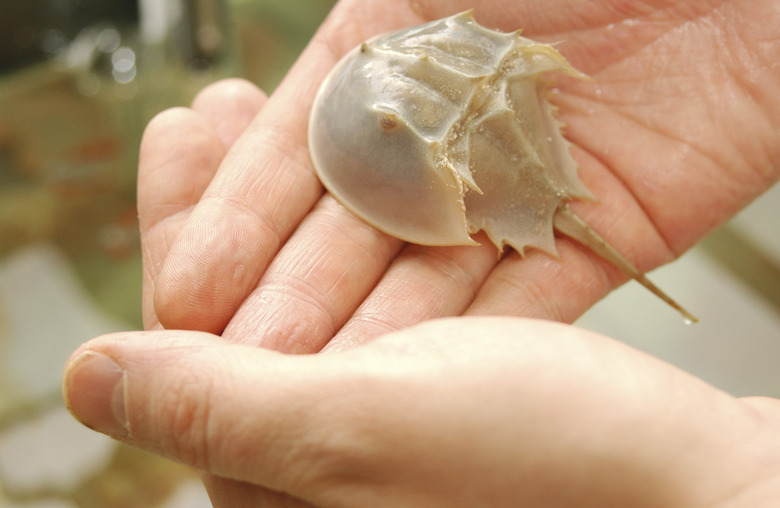Horseshoe Crab Science Project
The horseshoe crab is sometimes called a "living fossil" because the modern day crab and the fossil records of its ancestors are almost identical even after 300 million years. The horseshoe crab is an important animal in scientific study for many reasons. Medical researchers use its blood to test vaccine safety and some physiologists have studied the crab's eyes in order to better understand how the nervous system responds to light. Regardless of student age, science projects using horseshoe crabs can provide an opportunity to study animal physiology, conservation and adaptation.
Horseshoe Crab Anatomy
Horseshoe Crab Anatomy
Despite their name, horseshoe crabs are more closely related to spiders than crabs. In this project, your students will learn what makes these animals different. After a lesson on horseshoe and true crab anatomy, pass out anatomy diagrams and ask your students to name the different body parts depicted, focusing on the legs, pincers and tail of the animal. By the lesson's end, your students should be able to point to the horseshoe crab's lack of antennae and a pair of mandibles as well as their four extra legs as proof that the two animals are not part of the same "crab" family.
Keystone Species Project
Keystone Species Project
Keystone species maintain balance in an ecological system. A decline in the population of the species can be detrimental to the health of the system as a whole, since other animals depend on the keystone as prey, or as a predator for population control. The horseshoe crab is considered an Atlantic coast keystone species — its eggs are the main food source in a migrating shorebird's diet, and at later stages of life, the horseshoe crab supports other animals who use the crab as food or shelter, such as:
- leeches
- fish
- true crabs
- turtles
The recent decrease in the population of Atlantic horseshoe crabs puts other species at risk. When discussing food webs in the classroom, ask your students to draw a diagram reflecting the horseshoe's role in its ecological system and predict what would happen to other animals if the horseshoe crab's population changed. This project helps students understand the role conservation plays in preventing population imbalances in dependent species.
Live Crab Project
Live Crab Project
The live crab project helps students understand how information from a textbook can be applied in the real world. After studying the gender differences between horseshoe crabs in a textbook, your students should know that, though the females of the species are larger than the males, they have much smaller pincers. Bring in live specimens for students to examine. Students should be able to touch the crab and study its anatomy until they feel comfortable identifying the gender with a valid explanation.
Citizen Science Project
Citizen Science Project
If you're interested in participating in a widespread science project, Cornell University Cooperative Extension has begun a program that lets interested people — kindergartner and senior citizen alike — participate in professional research. Through the citizen science project, volunteers head to the beach at night in order to count and tag spawning horseshoe crabs. These numbers allow researchers at Cornell to better monitor horseshoe crab populations. Some horseshoe counters have reported catching a crab only to find that it had already been tagged. Because the tag numbers are archived, you can track the crab's path.
Cite This Article
MLA
Kerr, Suzy. "Horseshoe Crab Science Project" sciencing.com, https://www.sciencing.com/horseshoe-crab-science-project-12754430/. 22 September 2013.
APA
Kerr, Suzy. (2013, September 22). Horseshoe Crab Science Project. sciencing.com. Retrieved from https://www.sciencing.com/horseshoe-crab-science-project-12754430/
Chicago
Kerr, Suzy. Horseshoe Crab Science Project last modified August 30, 2022. https://www.sciencing.com/horseshoe-crab-science-project-12754430/
